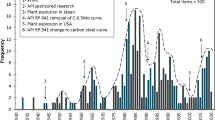Abstract
Nonferrous pyrometallurgical processes today operate at a high intensity requiring the best standards for the furnace refractory systems. From one plant to another, there is a range of process conditions such as temperature, slag chemistry, and feed types, and each of these parameters can influence refractory life. It is generally understood that process changes at plants can impact refractory life. The ability to test and understand refractory responses to a wide range of furnace operating conditions is therefore important. The RHI Technology Centre in Leoben, Austria is well equipped with laboratory and pilot plant facilities to evaluate refractory suitability over the range of conditions encountered in modern nonferrous pyrometallurgical systems. This article describes refractory testing at the RHI Technology Centre of the impact of two metallurgical slags on a number of different RHI test bricks. The slags were a fayalite slag and a calcium ferrite slag supplied by two smelter plants. High-temperature corrosion tests were carried out in a 250-mm-diameter induction furnace and a 165-mm-diameter short rotary kiln; each unit was lined with a number of refractory bricks and tested against attack by the particular slag. After testing, the refractory bricks were subjected to several laboratory tests to determine the extent of corrosion. Optimal refractory choices for the customers’ plants were developed based on the test results.







Similar content being viewed by others
References
H. Barthel, Wear of Chrome Magnesite Bricks in Copper Smelting Furnaces (Garland, TX: Interceram, 1981), pp. 250–255.
F. Harders and S. Kienow, Feuerfestkunde—Herstellung, Eigenschaften und Verwendung feuerfester Baustoffe (Berlin, Germany: Springer Verlag, 1960), p. 978.
G. Routschka, Refractory Materials (Essen, Germany: Vukan-Verlag GmbH, 2004), p. 512.
D. Gregurek and C. Majcenovic, Wear mechanism of basic brick linings in the non ferrous metals industry: case studies from copper smelting furnaces (RHI). Bulletin 1, 17 (2003).
F. Trojer, K.-H. Obst, and W. Münchberg, Mineralogie basischer Feuerfest-Produkte (New York: Springer Verlag, 1981), p. 180.
W.G. Davenport, M. King, M. Schlesinger, and A.K. Biswas, Extractive Metallurgy of Copper (Oxford, UK: Elsevier Science Ltd., 2002), p. 432.
F.K. Crundwell, M.S. Moats, V. Ramachandran, T.G. Robinson, and W.G. Davenport, Extractive Metallurgy of Nickel, Cobalt and Platinum-Group Metals (Oxford, UK: Elsevier Science Ltd., 2011), p. 610.
F. Pawlek, Metallhüttenkunde (New York: Walter de Gruyter, 1983), p. 865.
J.D. McCain and J.M. Floyd, eds., Converting, Fire Refining and Casting (Warrendale, PA: TMS, 1994), p. 381.
D. Gregurek, A. Spanring, A. Ressler, and S. Breyner, High Performance Brands for the Nonferrous Metals Industry (Warrendale, PA: TMS, 2012).
D. Gregurek, A. Ressler, V. Reiter, A. Franzkowiak, A. Spanring, B. Drew, and D. Flynn, State of the Art Refractory Corrosion Test Work for the Nonferrous Metals Industry (Warrendale, PA: TMS, 2013).
W.A. Deer, R.A. Howie, and J. Zussman, An Introduction to the Rock-Forming Minerals (Essex, UK: Pearson Education Ltd., 1992), pp. 3–15.
Acknowledgements
Thanks are given to our industrial research partners Boliden Minerals AB and Stillwater Mining Company for industrial support and providing the RHI Technology Center with the metallurgical slag samples. Thanks are also expressed for the opportunity for fruitful technical discussions which contributed to the success of the current study.
Author information
Authors and Affiliations
Corresponding author
Rights and permissions
About this article
Cite this article
Gregurek, D., Ressler, A., Reiter, V. et al. Refractory Wear Mechanisms in the Nonferrous Metal Industry: Testing and Modeling Results. JOM 65, 1622–1630 (2013). https://doi.org/10.1007/s11837-013-0758-1
Received:
Accepted:
Published:
Issue Date:
DOI: https://doi.org/10.1007/s11837-013-0758-1




